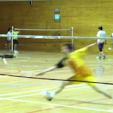Victor Brave Sword 9
Review Date : 25 December 2011
Racquet Type : Victor Brave Sword 9
Specs : 3UG2
Flex: Medium Stiff
Balance: 285 mm (Even Balance)
Strings: Yonex BG66 Ultimax
Tension: 24lbs, pre-stretched using Yonex ES5PROTECH
Grip: Gosen PU grip + Toalson overgrip
Technology : Sword (aerodynamic design), Inner Waves, Shockless and Nano-tec
Shuttles used: Apacs Aeroflight 700
First Impression:
Yeah, yeah...I know.
This racquet has been in existence for more than a couple of years.
I'm taking the plunge to wield this racquet.
This racquet needs no introduction since practically this racquet has been Lee Yong Dae's racquet ever since he converted to Victor.
On hindsight, Lee Yong Dae previously used a Yonex AT800 Defensive, hence it's no surprise the specs of Bravesword 9 is not too far off from the former to suit Lee Yong Dae.
This racquet looks somewhat plain Jane in silver colour overall with red/white highlights.
The racquet felt roughly even balance towards head heavy balance and felt semi stiff.
The frame felt solid and the swing felt pretty fast.
The racquet has 'sharp' edges for aerodynamics hence, the moniker, Sword.
Warm Ups:
Warming involves baseline to baseline forehand clears.
Clears are long and far owing to the aerodynamic and the flex of the racquet.
If one word is to describe this racquet is 'comfortable'.
Drives are pretty fast owing to how the racquet cuts through the air.
The racquet shaft is relatively thick and stable whereas the frame is aerodynamically shaped.
What this does is it made the racquet cuts through the air very fast while making it stable enough to control shots.
Generally, it plays quite similar to a Yonex Arcsaber 7 if there is ever a ballpark figure equivalent.
Game Time:
I won't go into detail each and every shots tried.
Generally since I am playing doubles, receiving of serve and serve are great as expected for a fast and stable racquet.
The ease of use of this racquet is apparent, as one can comfortably whip the racquet to hit shuttle gently or violently.
On the one hand, the lack of stiffness or weight on the head somewhat negates the control aspect of the racquet.
On the other hand, the racquet is very good on the defence and near the net owing to the medium flex and even balance.
This racquet shines best in the mid court range area as it is both good in attack and defence.
However, at the back court range, the control and power suffers a tiny bit as it it not heavy nor stiff enough like the Victor Super Waves 35 for power smash and perform controlled drops and power clears to the back court.
Nevertheless, the sweet spot is rather large and felt very easy to whip this racquet as the kickpoint is leaning towards the handle.
Conclusion:
This racquet's playability is great as it is very comfortable to wield this racquet both forehands and backhands.
The thing that strikes you, is how easy to wield this racquet.
Even Professionals like Lee Yong Dae and Nguyen Tien Minh have been using it for a long time and kept returning to it at the expense of newer and technologically advanced models.
Feel: 8.5/10
Control: 8.5/10
Power: 8.5/10
Defence: 8.5/10
Maneuverability: 8.5/10
Pros: Reasonably priced, ease of use and generally an all rounder racquet.
Cons: Almost none.
Suitability: beginner/intermediate/advanced players 3U and 4U
Player type: All rounder.
Footnote: this review was done as a hobby and as an interest to inform fellow badminton enthusiast. This is my personal opinion and in no form to promote this racquet.
Conflict of interest: None
Reference: Victor website (accessed @ 24/12/11)


















































